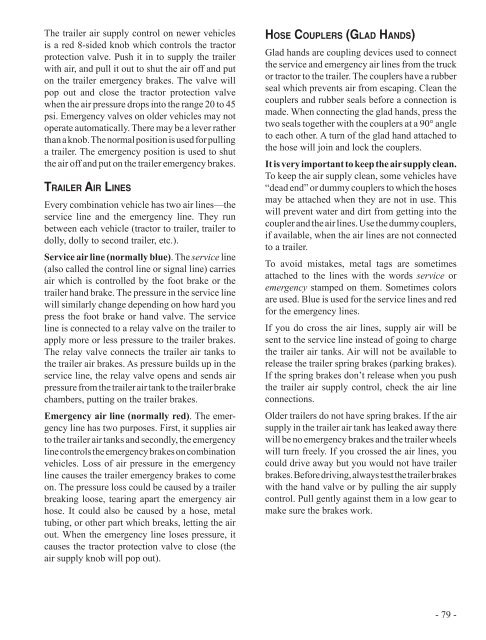Commercial Driver Handbook ( PDF ) - California Department of ...
Commercial Driver Handbook ( PDF ) - California Department of ...
Commercial Driver Handbook ( PDF ) - California Department of ...
You also want an ePaper? Increase the reach of your titles
YUMPU automatically turns print PDFs into web optimized ePapers that Google loves.
The trailer air supply control on newer vehicles<br />
is a red 8-sided knob which controls the tractor<br />
protection valve. Push it in to supply the trailer<br />
with air, and pull it out to shut the air <strong>of</strong>f and put<br />
on the trailer emergency brakes. The valve will<br />
pop out and close the tractor protection valve<br />
when the air pressure drops into the range 20 to 45<br />
psi. Emergency valves on older vehicles may not<br />
operate automatically. There may be a lever rather<br />
than a knob. The normal position is used for pulling<br />
a trailer. The emergency position is used to shut<br />
the air <strong>of</strong>f and put on the trailer emergency brakes.<br />
trailer air lines<br />
Every combination vehicle has two air lines—the<br />
service line and the emergency line. They run<br />
between each vehicle (tractor to trailer, trailer to<br />
dolly, dolly to second trailer, etc.).<br />
Service air line (normally blue). The service line<br />
(also called the control line or signal line) carries<br />
air which is controlled by the foot brake or the<br />
trailer hand brake. The pressure in the service line<br />
will similarly change depending on how hard you<br />
press the foot brake or hand valve. The service<br />
line is connected to a relay valve on the trailer to<br />
apply more or less pressure to the trailer brakes.<br />
The relay valve connects the trailer air tanks to<br />
the trailer air brakes. As pressure builds up in the<br />
service line, the relay valve opens and sends air<br />
pressure from the trailer air tank to the trailer brake<br />
chambers, putting on the trailer brakes.<br />
Emergency air line (normally red). The emergency<br />
line has two purposes. First, it supplies air<br />
to the trailer air tanks and secondly, the emergency<br />
line controls the emergency brakes on combination<br />
vehicles. Loss <strong>of</strong> air pressure in the emergency<br />
line causes the trailer emergency brakes to come<br />
on. The pressure loss could be caused by a trailer<br />
breaking loose, tearing apart the emergency air<br />
hose. It could also be caused by a hose, metal<br />
tubing, or other part which breaks, letting the air<br />
out. When the emergency line loses pressure, it<br />
causes the tractor protection valve to close (the<br />
air supply knob will pop out).<br />
hose Couplers (glad hands)<br />
Glad hands are coupling devices used to connect<br />
the service and emergency air lines from the truck<br />
or tractor to the trailer. The couplers have a rubber<br />
seal which prevents air from escaping. Clean the<br />
couplers and rubber seals before a connection is<br />
made. When connecting the glad hands, press the<br />
two seals together with the couplers at a 90° angle<br />
to each other. A turn <strong>of</strong> the glad hand attached to<br />
the hose will join and lock the couplers.<br />
It is very important to keep the air supply clean.<br />
To keep the air supply clean, some vehicles have<br />
“dead end” or dummy couplers to which the hoses<br />
may be attached when they are not in use. This<br />
will prevent water and dirt from getting into the<br />
coupler and the air lines. Use the dummy couplers,<br />
if available, when the air lines are not connected<br />
to a trailer.<br />
To avoid mistakes, metal tags are sometimes<br />
attached to the lines with the words service or<br />
emergency stamped on them. Sometimes colors<br />
are used. Blue is used for the service lines and red<br />
for the emergency lines.<br />
If you do cross the air lines, supply air will be<br />
sent to the service line instead <strong>of</strong> going to charge<br />
the trailer air tanks. Air will not be available to<br />
release the trailer spring brakes (parking brakes).<br />
If the spring brakes don’t release when you push<br />
the trailer air supply control, check the air line<br />
connections.<br />
Older trailers do not have spring brakes. If the air<br />
supply in the trailer air tank has leaked away there<br />
will be no emergency brakes and the trailer wheels<br />
will turn freely. If you crossed the air lines, you<br />
could drive away but you would not have trailer<br />
brakes. Before driving, always test the trailer brakes<br />
with the hand valve or by pulling the air supply<br />
control. Pull gently against them in a low gear to<br />
make sure the brakes work.<br />
- 79 -

















